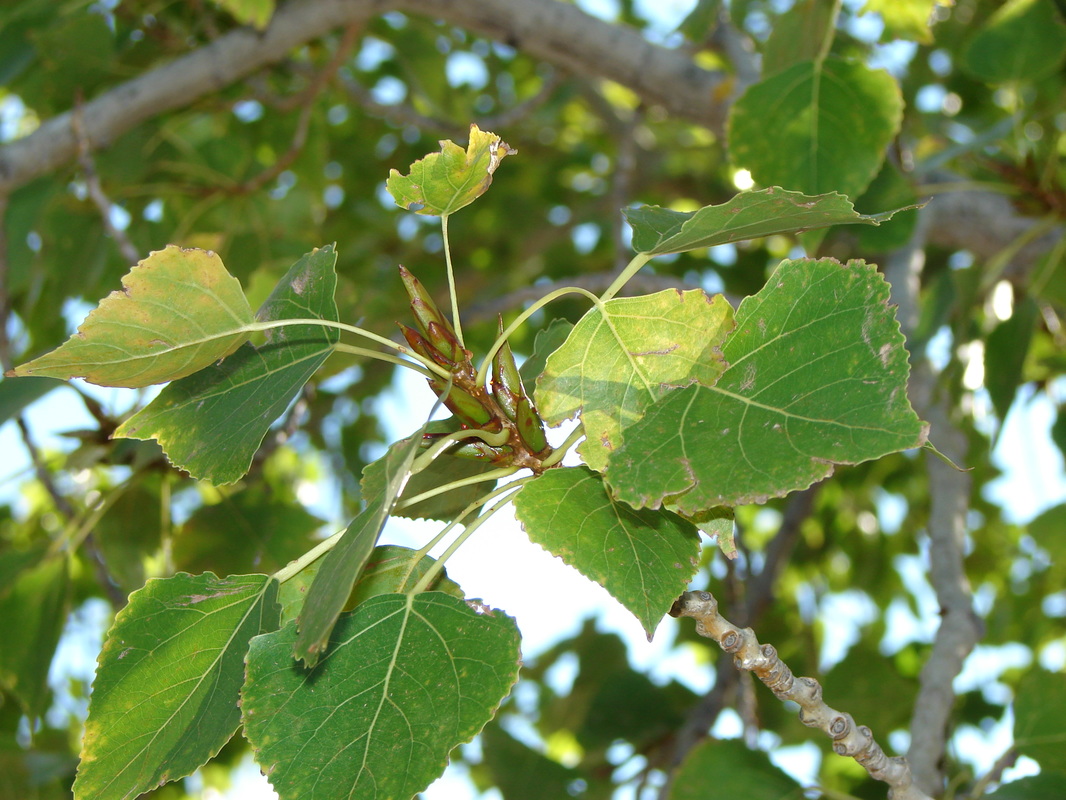BALM OF GILEAD (Poplar)
Scientific Name: Populus Balsamifera, Populus spp.
Other names: Balsam Poplar, Poplar buds, Populus gileadensis. French: Baumier. German: Mekkabalsambaum; Spanish: Bilsamo; Italian: Balsamo della Mecca; Indian: Gungal. Leaf buds.
Habitat: Canada and North America
Flowering and Fruiting: Balsam poplar generally reaches flowering age between 8 and 10 years. It produces large seed crops almost every year, but there can be significant variations in individual trees. Flowering occurs in April and May throughout most of the range, but not until June or July at northern limits and upper elevations.
Constituents
Poplars’ constituents are noted to include glycosides – Salicin (about 2.4%), salicortin, salireposide and various benzoate derivatives including populin (salicin-6-benzo-ate), tremuloidin (salicin-2-benzoate) and tremulacin (salicortin-2-benzoate).[1] Contains salicylates.
Other constituents are tannins (unspecified), triterpenes including a-amyrin and b-amyrin, carbohydrates including glucose, fructose, and various trisaccharides, fats, waxes.[1]
Action
Mild analgesic (forerunner of aspirin), Febrifuge, Anti-inflammatory, Stimulating diuretic (resin), Antiseptic, Circulatory stimulant, Expectorant. Buds: Poplar buds have antiphlogistic, antibacterial and wound healing effects. [1]
Uses
Laryngitis. Chronic bronchitis. Safe for children’s chest troubles. Traditionally used for coughs, colds and sore throats. Used to treat treatment of upper respiratory infections. Buds used by North American Indians for muscular and circulatory aches and pains (Dr. A. Clapp, 1852). [2]
Of the Balm of Gilead, Dr. Shook wrote: “It is seldom we meet with a laxative that is at the same time stimulant, tonic, diuretic, and anti-scorbutic, but here in this balsam tree we find all of these virtues. The chemistry of either its balsam or the laxative and tonic principles of its bark are practically unknown. What we do know is that it has been successfully used in a variety of diseases and the North American Indians considered it to be one of Nature’s best remedies for bad blood (scurvy), coughs and all chest complaints, stomach troubles, kidney and bladder diseases, rheumatism and all kinds of skin diseases.”
Approved by Commission E for hemorrhoids, wounds and burns
Solvent: alcohol
Preparation of Balm of Gilead
Preparations – Early Spring leaf buds [3]:
Tea: 2-3 buds to each cup boiling water; infuse 15 minutes. Half-1 cup 3-hourly, acute cases; thrice daily, chronic.
Tincture: BHC (vol 1). 1:5 45 per cent Ethanol, 4-8ml.[2] Tincture [Fresh, 1:2, Dry, 1:5, 75% alcohol] 15-30 drops.[3]
Balm of Gilead Cough Mixture (Potter’s). Each 10ml contains Acet. Scill. BP 0.339ml; Acetic acid (5.5 percent) extractive from Lobelia (1-12.5) 0.148ml; Ipecac Liquid extract BP 0.004ml; 30 percent alcoholic extractive (1:1) from each of 100mg Balm of Gilead buds and 200mg Lungwort lichen in a sweetened flavoured vehicle.
Infused oil: 1 part buds to 10 parts oil, for topical use.
Herbal Formula
Extract of Balm of Gilead Bark [4]
Ingredients:
1 pound of balsam poplar bark (cut)
1 gallon of distilled water.
Direction:
1. Boil slowly in an open pot for 30 minutes.
2. Strain and return the bark to the saucepan.
3. Cover with fresh water to 3 inches above the bark.
4. Boil until the water is level with the top of the bark. Strain and add the two liquors together.
5. Slowly reduce to one pint.
6. Add one pint high-grade glycerine.
7. Cool and bottle.
Dose
For adults: One to two teaspoonfuls at night upon retiring. Note the action and regulate the dose accordingly, as before stated, the result to be obtained is a soft molded stool 2 or 3 times a day. Avoid diarrhea.
For Children: Children from 5 to 15 drops in honey water according to age. This extract is 1 in 2 strength. It will keep indefinitely without losing its power. The average dose is one teaspoonful, but some cases react more than others, so it is advisable to start with small doses.
This formula has considerable tonic, digestive, resolvent, and discutient properties and is without any toxic principle. It rarely produces any griping pains or cramps, but is usually very mild in its action. In cases where pains are produced, a cup of hot ginger tea drank immediately after taking will prevent the pain.
Culinary Uses
Inner bark is best used in spring. Mucilaginous. The inner bark is often dried, ground into a powder and then used as a thickener in soups etc or added to cereals when making bread. The catkins are eaten raw or cooked and have a bitter flavor.
Other herbs called Balm of Gilead
1. Another plant that carries the name Balm Of Gilead, Commiphora gileadensis.
2. Another plant that carries the name Balm Of Gilead is Abies balsmea or Balsam Fir, the oil is used to make cough syrups.
3. Another plant that carries the name Balm Of Gilead is Cedronella canariensis, which is used to help to relieve the stuffiness.
Side effects
None known.
Reference
[1] PDR for Herbal Medicines (2000), published by Medical Economics Company, Inc. p. 607-609
[2] Bartram’s Encyclopedia of Herbal Medicine by Thomas Bartram
[3] Principles and Practice of Constitutional Physiology for Herbalists by Michael Moore
[4] Advanced Course in Herbology Dr. Edward Shook
https://www.srs.fs.usda.gov/pubs/misc/ag_654/volume_2/populus/balsamifera.htm
This article is copyrighted by Ital is Vital, 2025. Want to re-post this article? Visit our guidelines.
DISCLAIMER: THIS WEBSITE DOES NOT PROVIDE MEDICAL ADVICE
The information, including but not limited to, text, graphics, images and other material contained on this website are for informational purposes only. The purpose of this website is to promote broad consumer understanding and knowledge of various health topics. It is not intended to be a substitute for professional medical advice, diagnosis or treatment. Always seek the advice of your physician or other qualified health care provider with any questions you may have regarding a medical condition or treatment and before undertaking a new health care regimen, and never disregard professional medical advice or delay in seeking it because of something you have read on this website.
